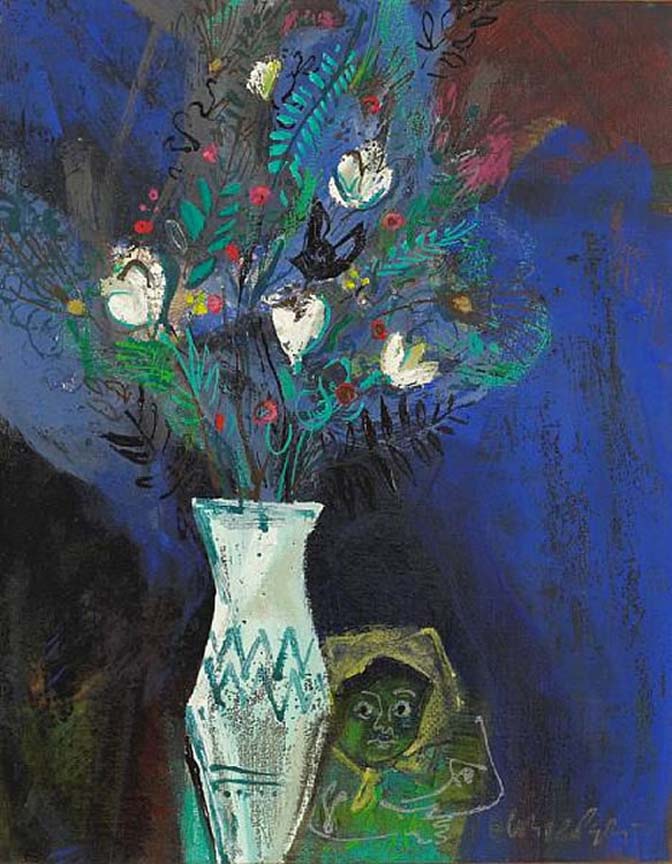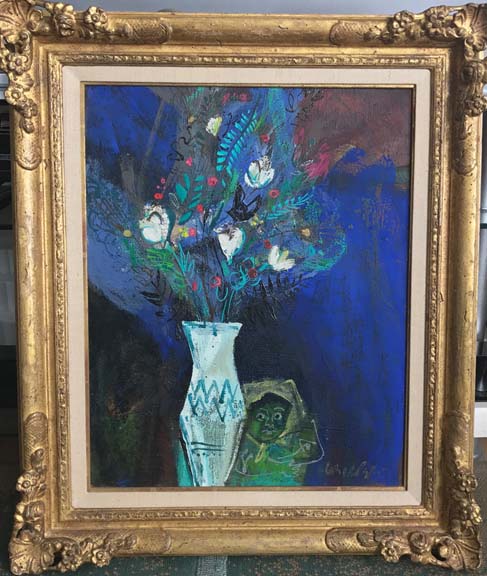

WILLIAM GROPPER
"FLORAL STILL LIFE"
OIL ON CANVAS, SIGNED
AMERICAN, C.1960
20 X 16 INCHES

William Gropper 1897-1977 William Gropper was born in New York City's Lower East Side in 1897. He was the first of six children to parents who earned small wages working in sweatshops. At the age of fourteen, Gropper left school to help support his family. While carrying bolts of cloth for his deliveries, Gropper began to draw on scraps of paper, sidewalks, and walls. A passerby saw some of these drawings and invited Gropper to attend a life-drawing class at the Ferrer School. He studied there for three years from 1912 to 1915, attending classes taught by Robert Henri and George Bellows. From 1915 to 1918 Gropper attended the New York School of Fine and Applied Art part-time on scholarship. Gropper also won a scholarship to the National Academy of Design, but remained as a student for only a short time; the rigid and systematic institution conflicted with Gropper's belief in the personal nature of art. At the New York School of Fine and Applied Art, Gropper earned several prizes. One of these prizes was for his cartoons, which led him to be hired by the New York Tribune in 1917 to sketch for their features. A few years later through freelance work, his cartoons and drawings appeared in other newspapers and magazines, such as The Liberator, The New Masses, The New York Post, The New Yorker and Vanity Fair. By the late 1920s Gropper was an established cartoonist and draughtsman. He sympathized with the labor movement and was a champion of peace and personal liberty. Gropper began to paint seriously, but privately, on these themes in 1921. Gropper's first exhibition of monotypes was held in 1921 at the Washington Square Book Shop in New York. At this time, he also began to do illustrations for books. Gropper took his first sketching trip in 1924 to the West with Morris Pass. By 1930 Gropper began to receive recognition as a fine artist. In 1934, he received two mural commissions from the Schenley Corporation in New York City. In 1935, he was commissioned to paint a mural for the Hotel Taft in New York City. In 1936, Gropper received several public mural commissions: one was for the Freeport, Long Island Post Office, which was completed in 1938 and followed by another mural for the Northwestern Postal Station, Detroit, Michigan. In his first gallery exhibition in 1936 at ACA Galleries, Gropper's work was so well received by critics, collectors, and artists that the following year he had two one-man exhibitions at ACA Galleries. In 1937, Gropper traveled west on a Guggenheim Fellowship and visited the Dust Bowl and the Hoover and Grand Coulee Dams, sketching studies for a series of paintings and a mural he painted for the Department of the Interior in Washington, DC. That same year he had paintings purchased by both the Metropolitan Museum of Art and the Museum of Modern Art. Gropper exhibited at the 1939 New York World's Fair, Whitney Museum of American Art (1924-55), Art Institute of Chicago (1935-49), Carnegie International (1937-50), Pennsylvania Academy of the Fine Arts (1939-48), and National Academy of Design (1945-48). He was a founder of the Artists Equity Association and member of the National Institute of Arts and Letters. From 1940 to 1945 William Gropper was preoccupied with anti-Nazi cartoons, pamphlets, and war bond posters. In 1943 he was selected by the War Department Art Advisory Committee to go to Africa and make a pictorial record of the war front there. In 1944 he participated in the exhibition Artists for Victory at the Metropolitan Museum of Art, winning first prize in lithography. In 1944 Gropper moved from Herman Baron's ACA Galleries to the gallery Associated American Artists, where he was given a one-man exhibition. In 1945 Gropper covered the charter conference of the United Nations in San Francisco for the left-wing periodicals Freiheit and The New Masses. During the 1950s Gropper was attacked for his refusal to cooperate with the McCarthy Committee and the effect was an end to his exhibitions and commissions until 1961. After a major traveling retrospective exhibition in 1968-1970, William Gropper was offered the position of Artist-in-Residence at the Museum of Arts and Science, Evansville, Indiana. Gropper was given a major traveling exhibition of his drawings in 1971. He died in 1977. |